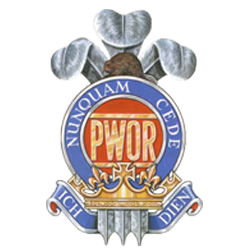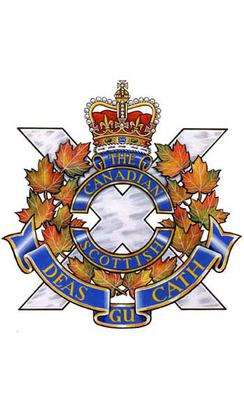
The Canadian Grenadier Guards (CGG) is a reserve infantry regiment in the 34 Canadian Brigade Group, 2nd Canadian Division, of the Canadian Army. The regiment is the oldest and second-most-senior infantry regiment in the Primary Reserve of the Canadian Army. Located in Montreal, its main role is the provision of combat-ready light infantry troops in support of Canadian regular infantry. It is a Household Foot Guard regiment and also provides soldiers for public ceremonial duties, performing similar ceremonial duties as the Guards regiments of the British Army. This primarily entails mounting the guard at Government House, the King's and Governor General's residence, and performing the "Changing the Guard" ceremony on Parliament Hill in Ottawa, a task it shares with Canada's senior Household Foot Guard regiment, the Governor General's Foot Guards of Ottawa. The Canadian Grenadier Guards is an allied regiment to the British Grenadier Guards.
The Canadian Expeditionary Force (CEF) was the expeditionary field force of Canada during the First World War. It was formed following Britain’s declaration of war on the German Empire on 15 August 1914, with an initial strength of one infantry division. The division subsequently fought at Ypres on the Western Front, with a newly raised second division reinforcing the committed units to form the Canadian Corps. The CEF and corps was eventually expanded to four infantry divisions, which were all committed to the fighting in France and Belgium along the Western Front. A fifth division was partially raised in 1917, but was broken up in 1918 and used as reinforcements following heavy casualties.

The Princess of Wales' Own Regiment (PWOR) is a Primary Reserve infantry regiment of the Canadian Army.

The Canadian Scottish Regiment (Princess Mary's) is a Primary Reserve infantry regiment of the Canadian Army based on Vancouver Island in British Columbia.
The 162nd Battalion, CEF was a unit in the Canadian Expeditionary Force during the First World War. Based in Parry Sound, Ontario, the unit began recruiting in late 1915 in that city. After sailing to England in November 1916, the battalion was absorbed into the 3rd and 4th Reserve Battalions on January 4, 1917. The 162nd Battalion, CEF had one Officer Commanding: Lieut-Col. J. M. Arthurs.

The 199th Battalion, CEF was a unit in the Canadian Expeditionary Force (CEF) during the First World War.

The Royal Regina Rifles is a Primary Reserve infantry regiment of the Canadian Army. Prior to 1982 the regiment was known as The Regina Rifle Regiment. The Royal Regina Rifles are part of 3rd Canadian Division's 38 Canadian Brigade Group.

The Queen's York Rangers (RCAC) is a Canadian Army Primary Reserve Royal Canadian Armoured Corps regiment based in Toronto and Aurora. The regiment is part of 4th Canadian Division's 32 Canadian Brigade Group. The regiment consists of one cavalry squadron, as well as the Headquarters and Training Squadron. The regimental family also includes The Queen's York Rangers Band (volunteer), along with two Royal Canadian Army Cadet corps and a Royal Canadian Air Cadet squadron. The unit mottos are pristinae virtutis memor – 'remembering their glories in former days' – and celer et audax – 'swift and bold'. Among its own members and those of other regiments, the unit is referred to as the Rangers. The name is abbreviated as QY Rang, and sometimes pronounced KWY-rang.
The 13th Battalion (Royal Highlanders of Canada) of the Canadian Expeditionary Force was an active service battalion during the First World War.

The 16th Battalion, CEF was a unit of the First World War Canadian Expeditionary Force. It was organized at Valcartier on 2 September 1914 in response to the Great War and was composed of recruits from the 91st Regiment Canadian Highlanders, the 79th Cameron Highlanders of Canada, the 72nd Regiment "Seaforth Highlanders of Canada", and the 50th Regiment "Highlanders".

The Victoria Rifles of Canada was an infantry regiment of the Non-Permanent Active Militia of the Canadian Militia and later the Canadian Army. First formed in Montreal, Quebec in 1862, the regiment would see a history of service stretching from the Fenian Raids of the 1860s-70s right into the middle of the 20th Century. In 1965, the regiment was reduced to nil strength and transferred to the Supplementary Order of Battle.
The 50th Battalion (Calgary), CEF, was an infantry battalion of the Canadian Expeditionary Force during the Great War. The 50th Battalion was authorized on 7 November 1914 and embarked for Britain on 27 October 1915. The battalion disembarked in France on 11 August 1916, where it fought as part of the 10th Canadian Infantry Brigade, 4th Canadian Division, in France and Flanders until the end of the war. The battalion was disbanded on 30 August 1920.

The 3rd Battalion, Canadian Expeditionary Force was an infantry battalion of the Canadian Expeditionary Force that saw service in the First World War. It was created on 2 September 1914 with recruits from Toronto, primarily from the Queen's Own Rifles of Canada with additional drafts from the 10th Royal Grenadiers and the Governor General's Body Guard.
The 23rd Reserve Battalion, CEF was an infantry unit in the Canadian Expeditionary Force during the First World War.
The 1st Battalion, Canadian Mounted Rifles, CEF, was an infantry battalion of the Canadian Army. Raised for service during the First World War as part of the Canadian Expeditionary Force (CEF), it was formed in November 1914, in Brandon, Manitoba. Originally a mounted infantry unit named the 1st Regiment, Canadian Mounted Rifles, CEF, which was expanded, following its rerolling and dismounting as an infantry unit, by absorbing other units of the Canadian Mounted Rifles (CMR).

The 2nd Canadian Mounted Rifles Battalion, was authorized on 7 November 1914 as the 2nd Regiment, Canadian Mounted Rifles, CEF. The battalion recruited in Victoria and Vernon, British Columbia and was mobilized in Victoria. An earlier incarnation was raised for Boer War.

The 5th Battalion, CEF, known as "Tuxford's Dandys," was an infantry battalion of the Canadian Expeditionary Force during the Great War.
The Canadian Fusiliers (City of London Regiment) was an infantry regiment of the Non-Permanent Active Militia of the Canadian Militia (now the Canadian Army). In 1954, the regiment was amalgamated with The Oxford Rifles to form The London and Oxford Fusiliers (now the reserve battalion of the Royal Canadian Regiment).

The 73rd Battalion, CEF was an infantry battalion of the Canadian Expeditionary Force during the Great War. The 73rd Battalion organized in June 1915, initially commanded by Lieutenant-Colonel Peers Davidson, was placed on 'Active Service' as an 'Overseas Battalion, on 10 July 1915, as authorized in Militia General Orders.
The Peterborough Rangers was an infantry regiment of the Non-Permanent Active Militia of the Canadian Militia. In 1936, the regiment was amalgamated with the 3rd Prince of Wales' Canadian Dragoons to form The Prince of Wales Rangers.












